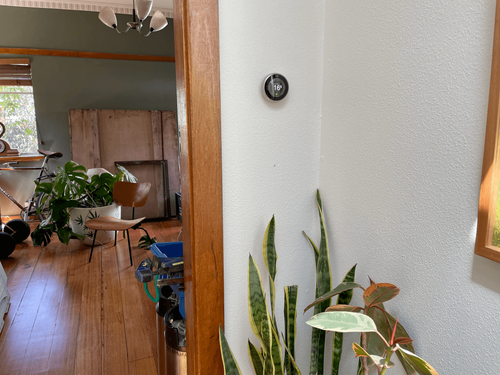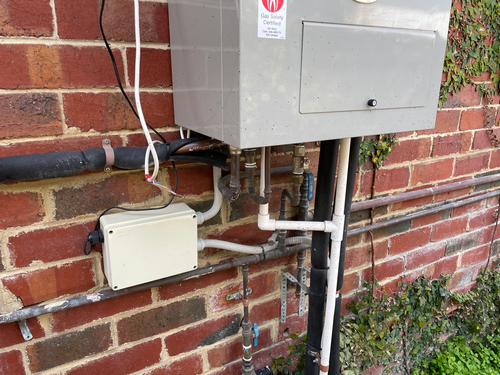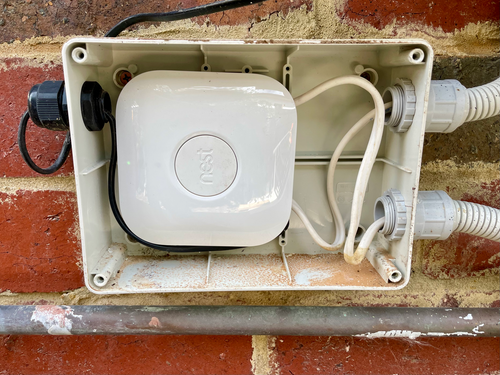Installing a Nest thermostat in Australia
Nest still doesn't sell their thermostats for the Australian market, so it can be hard to work out what you need. Here's what I found out.

Nest thermostat installed in our place in Melbourne. We later extended the house so the adjacent living area is sort of unused at the moment.
Update 08/10/21
I never actually meant to publish this post. I wrote a draft which somehow ended up getting published and then became the most visited page on this whole site!
This post could certainly do with a revision, but here's a quick update:
Five years later, our Nest is still going strong and has been mostly pleasurably and straightforward to use. Would I install it again? Probably not. Since we bought ours, the whole thing has migrated into the broader Google ecosystem and is not nearly so extensible as what one would expect of a smart home device in 2022. From my preliminary investigation, Ecobees seem much better.
For that matter, however, I certainly wouldn't install gas hydronic heating again. My climate crisis awakening hadn't come five years ago... and gas was also a lot cheaper.
I explored heat pump hydronic back in 2017, but it was a technology that was just on the cusp back then. I'll be converting this system to be heat pump powered as soon as I can stomach the $25k cost or it becomes a bit more affordable or rising gas costs or crises of conscience force my hand.
We recently installed a hydronic heating system into our 1940s clinker brick house in West Preston. I really, really wanted a Nest thermostat except that they aren't officially available in Australia and of course, have no local support. Because of that, most heating companies are a bit reluctant to put one in for you.
They have a bad reputation, too, since the first two versions were fairly prone to issues. Nest v3 has, as far as I can tell, fairly well ironed out the majority of these issues and seems to work very well. I spent a fair bit of time investigating and agonising over the various options for getting one installed, so if you're in a similar situation hopefully this will clear things up for you.
So, how did we install a Nest thermostat in our Australian hydronic heating system?
Firstly, I bought an American version of the Nest on eBay which turned out to be entirely wrong. The American version is designed to control ducted split systems which supply both hot and cold air. If that's what kind of system you have, stop reading now as I have no advice for you whatsoever.
The UK/European version is designed for hydronic heating systems which heat hot water at a boiler and then pump it into coiled radiators around the house to distribute heat.
When purchasing one, the differences between them are not hugely clear, except from the fact that the box of the American edition has a Nest showing a blue display (e.g. air con mode) and the UK/Euro edition shows one with an orange display (heating, geddit?).
I spent a lot of time trying to find somewhere that would ship me a UK thermostat and eventually found a British seller on eBay who would, although I paid about $50 or so over the odds.
Don't make the same mistake I did! It turns out that Amazon.co.uk will ship these to Australia for a very reasonable price.
How do you install it?
Firstly, I'd recommend not doing it yourself. There are huge big threads on Whirlpool with competing advice on installation which I found pretty confusing and overwhelming.
We had our heating installed by Hubair and if you're looking for hydronic heating in Melbourne, I'd really recommend using these guys: incredibly helpful, friendly and overall great value. I was a needy, annoying customer and they were always patient and friendly.
They were slightly trepidatious about installing the Nest due to its lack of local support. Some months prior they'd installed an EcoBee for another client and it turned into a bit of a nightmare where they had to spend weeks trying to get the whole thing working. Nevertheless, they agreed to give the Nest a go and it ended up being fairly simple.
How does a normal installation work?
Like most conventional thermostats, the Nest is powered by a 12v cable coming out of the radiator and run through the walls to your thermostat.
The Nest does not talk to your boiler directly, but instead communicates wirelessly with a device called a Heatlink. The Heatlink is a small box which is wired directly into your boiler's 'call for heat' circuit. When the temperature dips below the setting on the thermostat, the Nest communicates to the Heatlink which talks to the boiler.
What's different about an Australian install?
Nothing much, except for one important fact: in Europe and the UK, most people have their boilers inside a cupboard in their kitchen or in a utility room with an exhaust pipe ducted out the window.
In Australia, we tend to have our boilers externally mounted on the side of our house.
The boiler we went for was a Immergas Imtec 30. They sell this in an 'internal' and 'external' versions. The latter is the internal version but housed within a solid metal case with a panel you can flip up the access the controls.
Because of this, the Heatlink is not weather sealed and is fairly unsuitable to being directly mounted on the outside of the house. I was fairly concerned about how this might work. Could we mount it in a kitchen cupboard inside and run a cable back to the Nest? Could we mount it on the inside of the boiler case?
For various reasons, neither of those solutions was really ideal but fortunately the electrician from Hubair had a much better idea. He mounted the Heatlink in a plastic weather proofing box on the side of the house, next to the boiler. It's got a 240v plug for power (which is plugged into the same external outlet as the boiler) and is wired into the boiler directly.

The Heatlink unit is mounted in a weatherproof box outside and connected to my boiler

Here's the Heatlink unit itself
The Heatlink communicates with the nest over a mesh wifi network and as such they need to be within 30m of each other. Our place is single brick veneer and the Heatlink and thermostat are installed only 10m apart and have no issues but if you live in a concrete bunker you may find installing the Heatlink externally is problematic.